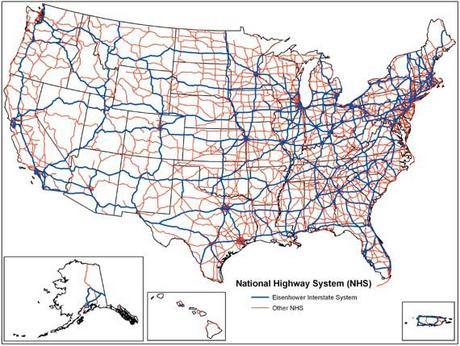 Just over 50 years ago, the interstate system came into being. President Eisenhower signed the Federal-Aid Highway Act of 1956 on June 29th with the aim of improving travel across the country. According to the National Highway Administration, “President Eisenhower considered it one of the most important achievements of his two terms in office.”By looking at the Interstate System, we start to see how an undertaking like high speed rail might be possible. Federal and state cooperation would be key. With several recently inaugurated governors voicing their concern over such a project, development of the Interstate may provide some clues as to how to deal with a potentially massive undertaking.
Just over 50 years ago, the interstate system came into being. President Eisenhower signed the Federal-Aid Highway Act of 1956 on June 29th with the aim of improving travel across the country. According to the National Highway Administration, “President Eisenhower considered it one of the most important achievements of his two terms in office.”By looking at the Interstate System, we start to see how an undertaking like high speed rail might be possible. Federal and state cooperation would be key. With several recently inaugurated governors voicing their concern over such a project, development of the Interstate may provide some clues as to how to deal with a potentially massive undertaking.
Today President Obama has put forth high-speed rail as the 21st century’s version of the interstate system. In a country that depends heavily on cars, what role does high speed rail have? Eric asked his dad what he remembered of the Interstate System in its infancy. Just starting off to college at the time, he recalled how much easier the highway system made travel, as opposed to taking only county and state highways. In the early part of the 1950s, his family drove across the United States on multiple occasions for his father’s work. What if rail travel were the beneficiary of President Eisenhower’s vision?Eric’s dad didn’t recall the debate and partisanship associated with the institution of a highway system. In this era of budget deficits, asking for more than $50 billion dollars to construct high speed rail is sure to raise some flags. If high speed rail can cut down on congestion, emissions, provide jobs, and save people money (through reduced wear and tear on their cars and fuel expenses), then it may have a shot. However, in this economic and political climate it faces a seemingly uphill battle.There is also the reality that we can’t have everything we want at the same time. There is also a big push going on for electrification of the transportation sector; not only regarding the production and adoption of all-electric and plug-in hybrid vehicles but also for building up charging infrastructure and consumer awareness and knowhow in cities across the country. This is all a part of the smart grid movement. Given the reliance on cars in America for everything from going to buy groceries to getting to work to seeing relatives on the holidays, wouldn’t a switch to electric cars be easier and still have the benefits of reduced dependence on fossil fuels and less pollution over time?The interstate system now comprises 46,876 miles. The completion of the system, at a cost of $129 billion, was a cooperative federal-state undertaking. Each state transportation department managed its own program for location, design, right-of-way acquisition, and construction. The states also were responsible for the ownership and maintenance of the system, and in 1981, they began receiving federal funds for maintenance.
Congress provided revenues from the federal gasoline tax to provide 90 percent of the cost of the construction of the interstates with the states picking up the remaining 10 percent. The technical standards for the highways were highly regulated—lanes had to be 12 feet wide and shoulders 10 feet wide, the bridges had to have 14 feet of clearance, grades had to be less than 30 percent, and the highway had to be designed for travel at 70 miles an hour. The most notable attribute of the system is the limited access concept. The 42,000-mile system only has approximately 16,000 interchanges.
[Image]

